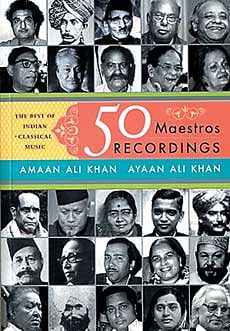Playing the bridge

The 192-pager is no detailed biography of some of the greatest classical musicians India has ever seen. It is more of a ready reckoner that gives us a brief life sketch of the legends, even while telling us whose music influenced the sons of Sarod maestro Ustad Amjad Ali Khan in their musical journey. But what adds value to the endeavour is a special audio CD accompanying the book, comprising 50 vintage recordings culled out from various past recordings, making it a unique collector’s album.
Amaan and Ayaan, who had kept away from public performances for over a year under instruction from director J P Dutta in whose aborted film they were slated to make their big screen debut, used some of their free time to dig out from their memories the music that took them into the world of euphony.
Presented as a tribute to the masters that influenced them, the book is a perfect introduction for anyone who is interested in getting initiated into the world of Indian classical music. What makes the brief chapters on each of the musicians interesting is Amaan and Ayaan’s recalling of their personal interactions with them, something they’ve had the advantage of by virtue of belonging to a household that is into its seventh unbroken generation of classical music.
The brothers have made it more interesting by giving descriptions of the recordings that have been included in the CD in a language that is understood by even a lay listener. In one compendium they’ve brought together some of the most famous artistes and some giants who have been forgotten outside the hardcore classical world with the passage of time — such as Ustad Ahmed Jaan Thirakhwa, Surashri Kesarbai Kerkar, Maharajapuram V Santhanam and Mogubai Kurdikar — names that the present generation has possibly not heard of.
The idea behind the book was exactly that, to bring onto one platform all the greats of classical music, making it a kind of crash course for youngsters. “The idea was that we could be a bridge between the younger generation and the stalwarts of the classical music world,” says Ayaan.
Amaan agrees, “We are young musicians connected with the youth. And while writing this book, we kept in mind any newcomer who would want to be in the trail of Indian classical music. The 44 names in these 50 recordings are not mere musicians, they are institutions. For example, Ustad Shahid Pervez is a great sitarist, but we have included Ustad Vilayat Khan. Why? The difference is that Vilayat Khan is an institution. There are 50,000 sitar players who follow him or Pandit Ravi Shankar. We have talked about three aspects — first the recording, then the person and then about our personal rapport with that person. Even if we have not met all of them, we have known them through their music.”
For the duo, as also for everyone else, these names are the primary pillars of Indian classical music. “Every classical musician today owes it to them, because they had the sophistication, the class, the profile, the genius. Whatever else we hear is inspiration, and I can say that in all honesty because we have grown up amidst music,” says Ayaan.
The concept behind the book is to connect young people to Indian classical music, which is why the authors have stuck to simple language. “There are not too many technical jargons and if anyone wants to get initiated into classical music, they must know these names,” puts Ayaan succinctly. The only problem while compiling the book was the copyright issue pertaining to a few recordings because of which they could not be included in the project. But as Ayaan philosophises, “Life is all about some give and take.”